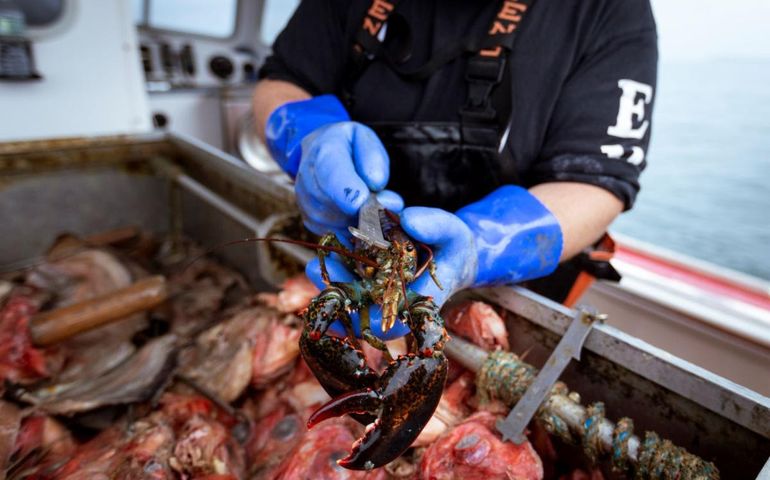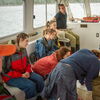Lobster fishery, coming off a record year, faces challenges ahead
 Courtesy / Maine Center for Coastal Fisheries
Gov. Janet Mills and the Maine Lobstermen's Association decried a new report that urges consumers to "avoid" lobster.
Courtesy / Maine Center for Coastal Fisheries
Gov. Janet Mills and the Maine Lobstermen's Association decried a new report that urges consumers to "avoid" lobster.
Maine’s lobster fishery scored a record-breaking value in 2021, with a 75% increase over 2020 and a 10% increase in landed weight.
But fishermen face increasing pressures, including difficulty finding and keeping crew, rising operational costs, competition for fishing grounds from other industries, new regulations affecting fishing gear and methods and coastal development pressure that’s squeezing waterfront access and opportunities to live they work.
There are plenty of long-term studies on the lobster side of the fishery. For example, the University of Maine’s Lobster Institute handles the American Lobster Settlement Index, which monitors larval lobsters and their environment.
Now a new study is underway to study the human side of the fishery.
“Last year’s season was the most valuable ever,” said Theresa Burnham, a University of Maine research associate and a member of the study’s research team.
While the news was welcomed by fishermen and coastal communities across Maine, "other headlines in 2021 pointed out the fishery has been facing serious challenges in the last year,” she said.
Burnham gave a presentation on the study’s progress during a recent panel discussion hosted by the Maine Center for Coastal Fisheries in Stonington.
Called “Social Indicators of Resilience in Maine’s Lobster Fishery,” the goal is to identify and track indicators of social or economic resilience of the fishery in order to help inform future management decisions.
The study is a collaboration between Maine Center for Coastal Fisheries, the Maine Lobstermen’s Association, and the Maine Department of Marine Resources, and is led by Dr. Josh Stoll at the University of Maine.
Burnham and others on the team presented some early findings from fishery interviews conducted in 2021. Metrics were suggested by the fishing industry as factors toward understanding the resilience of the fishery.
The team is now identifying existing datasets to develop indicators of how the fishery is doing.
Maine’s biological monitoring program of lobster has been called “the Cadillac of monitoring,” said Burnham.
In the same way, she said, the team’s goal is to monitor the human side of the fishery for the resilience of lobstermen and coastal communities in an equally extensive way.
Currently, landings and value are the primary metrics use to understand the status of the fishery. The Department of Marine Resources recently reported that 2021 was the most valuable year in the history of Maine's lobster fishery. At $725 million, the landed value for the fishery increased by 75% over 2020. Total landed weight for 2021 was 108 million pounds, an increase of more than 10 million pounds over 2020, or more than 10%.
That trajectory leads to the assumption that, if the numbers go up, things are good in the fishery, Burnham said.
“Following that logic, 2021 was an extremely good year for the fishery,” she said. “But that data might not fully capture the serious challenges the fishery faces. That highlights the need for additional social economic metrics.”
When the data collection process is complete, the team will take its findings to the industry to learn how well the data reflect industry’s perspective and to improve it.
For example, she said, interviews revealed that coastal accessibility is a challenge as property values across Maine increase, making it difficult for fishermen, their crews, and people in related businesses to live where they work.
Those anecdotal observations were supported by real estate data that showed a steep rise in average listing prices over the last five years, while the total number of listings declined.
Using property transfer tax records, the team found that the composition of many new property owners in coastal towns have moved there from other states. It was also possible to detect a general migration of fishing license holders to homes further inland.
“That’s a change from traditional fishing towns,” Burnham said.
Stonington, Maine’s No. 1 landing port, in particular provided insight into a dramatic real estate trajectory.
“The only thing is, it’s migrating a lot faster than maybe what your data is reflecting,” said Stonington Town Manager Kathleen Billings.
The data reflect how hard it will be for fishermen to live in the town going forward, she said.
“We’re at a point now where we won’t be able to compete for real estate,” said Billings. “That’s going to be a problem.”
In addition to coastal accessibility, the team is collecting data on the physical and mental health of fishermen and the financial aspects of their business, such as profitability, business investments and personal spending. They’re also studying community composition, using existing data sets on things like property transfer taxes, homestead exemptions, lobster licenses per town, age distribution, and working waterfront access points.
“We’re not trying to link indicators to specific regulations,” said Burnham. “We want to find a way to measure how the industry is doing.”













0 Comments